Coimbatore Taxi Home » Tour Informations
Find a Cab - Out Station Round Trip
Find a Cab - City Local
Find a Cab - Oneway Dropping Fixed
Find a Cab - Tour Packages
Coimbatore Taxi Home » Tour Informations
| Chennai |

| Chennai - Gateway to South India |
| Chennai is the largest city in Tamil Nadu and is located on the southeastern coast of India. The city was formerly known as Madras and was established by the British. They developed it into a significant urban center and naval base. Around 20th century, Chennai became an important administrative headquarter and the capital of Madras Presidency. The growth and expansion of British Empire led to development of the city. It has been endowed with the rich heritage of art and culture. It is for this reason that Chennai is also called as the 'Gateway to South India'. The city been blessed with the wealth of arts and literature. It is famous for its various cultural events, showcasing the performing arts such as Dance, Music and Drama at its best. Tamil literature is very rich in content and preaches ancient morals and values. Chennai is also popular for the glitz and glamour of Kollywood, the 'Tamil film industry'. Many Tamil films have won acclaim in the international film festivals and have brought fame to India. Today, the city has gone through a tremendous change and is developing rapidly. There are a number of industries here such as automobile, technology, hardware manufacturing, and healthcare industries. The Automobile industry in Madras is one of the leading industries in the country. It is also the second largest exporter of Information Technology, after Bangalore. Apart from this, the city is a leading player in the fields of education and sports. There are a number of reputed educational institutions and stadiums here which mark the significance of the two in Chennai. |
| Chennai Tourist Attractions |
| Chennai is hailed to be the liveliest city in entire South India. The city has its own unique charm, which sets it aside from the rest of the big cities. The vibrancy of rich culture and traditions exuded by the city and its residents is simply moving. It is one such city in Tamil Nadu, which has been blessed with an extreme treasure of tourist attractions. The sightseeing tour around the ancient city of Madras, will completely sweep you off your feet. Besides, there is such wide diversity that you will be amazed at its existence. The tour includes beautifully carved temples, serene beaches, colonial monuments and much more. So, come and explore the magnificent city of Chennai, rightly called the 'Gateway to South India'. Fort Museum 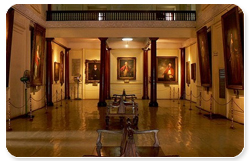 The museum has on its display many relics belonging to the times of British Raj in India and exhibits a collection of contemporary paintings as well as the rare military paraphernalia such as weapons, uniforms, coins, costumes and medals. The museum has on its display many relics belonging to the times of British Raj in India and exhibits a collection of contemporary paintings as well as the rare military paraphernalia such as weapons, uniforms, coins, costumes and medals.Fort St. George Built in the 17th century, this fort was built under the supervision of Francis Day and Andrew Cogon and houses St. Mary's Church and a museum. Built in 1680, St. Mary's Church is the oldest Anglican Church in India and has some of the oldest British tombstones in India. It was here that the marriage of the couple who founded the Yale University in the States was solemnized. The best time to visit is on a Sunday. Tel: 2566566 Kapaleeswarar Temple 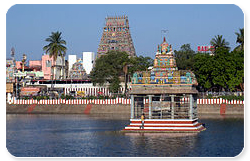 The biggest temple in the city is a fine specimen of Dravidian architecture. The Shaiva temple has 13th century inscriptions and a 37-metre gopuram remarkable for its intricate carvings depicting stories from Hindu mythology. Sri Parthasarathi Temple The 8th century Krishna temple was built under the patronage of the Pallavas and enshrines idols of the five avataras of Sri Vishnu. The small temple inside is dedicated to Vishnu's consort, Vedavalli Ammai. Santhome Cathedral San Thome at the southern tip of Marina features the beautiful stained glass window at the basilica depicting the story of St Thomas and the central hall that has 14 wooden plaques depicting scenes from the last days of Christ. The 3-ft high statue of Virgin Mary was imported from Portugal in 1543. The Snake Park and Children's Park 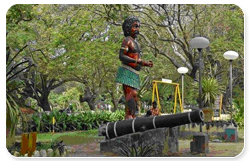 The snake park with diverse Indian snakes and reptiles and nearby children's park with a large playing ground and a good collection of birds and animals are worth a visit. The snake park with diverse Indian snakes and reptiles and nearby children's park with a large playing ground and a good collection of birds and animals are worth a visit.The Marina Beach 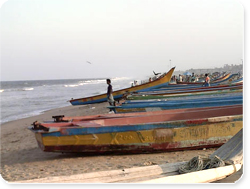 The 12-km long famous Marina Beach is the second longest beach in the world. It is best to visit the beach early in the mornings or late in the evenings when the area becomes a virtual fair ground with food stalls and other entertainments. The Theosophical Society The world headquarters of the much-famed Theosophical Society that promotes study of comparative religion, philosophy and science is in Adyar enclosing shrines of all faiths, Garden of Remembrance and 95-year old library with an astounding collection of rare Oriental manuscripts written on palm leaves and parchment. Kalakshetra In Thiruvanmiyur, Kalakshetra or 'Temple of Art' aims to train, encourage and revive interest in Bharatanatyam, classical dance form of Tamil Nadu, textile designing and weaving and is one of the best in its arena. Birla Planetarium The Birla Planetarium at Kotturpuram is the most modern planetarium in the country with the fully computerized projector. Nearby is the Periyar Science and Technology Museum that may of interest to fans of science and technology. Timings: 10.45 am - 1.45pm and 3.45 pm. Holiday Sunday. Ph: 24416751,24410025 National Art Gallery and Government Museum The museums at Egmore, founded in 1857, display exhibits related to archaeology, geology, anthropology, numismatics, botany and zoology along with sculpture and armory. Timings : Saturday to Thursday from 1000 to1700. Valluvar Kottam 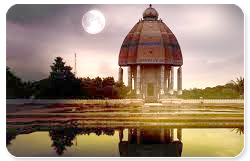 The memorial to the great poet-saint of Tamilian literature, Tiruvalluvar, is actually the replica of the temple chariot in Thiruvarur. A 33m tall statue of the saint has been installed in the chariot. His famous work Thirukkural has been inscribed on stone in the front hall corridors of the chariot. The memorial is said to have the largest auditorium in Asia with a capacity of 4000 people.
The memorial to the great poet-saint of Tamilian literature, Tiruvalluvar, is actually the replica of the temple chariot in Thiruvarur. A 33m tall statue of the saint has been installed in the chariot. His famous work Thirukkural has been inscribed on stone in the front hall corridors of the chariot. The memorial is said to have the largest auditorium in Asia with a capacity of 4000 people.Entrance Fee : Adult Rs. 2/-, Children Rs. 1/- Timings : 8.00 a.m. to 6.00 p.m. No Holidays. Location : Valluvar Kottam High Road, Nungambakkam, Chennai - 34. Tel : 28172177 Guindy National Park 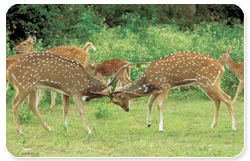 This is the countries only Wildlife Sanctuary within a city's limits. This park spread over an area of 27.6 sq. km. Raj Bhavan, the Governor's mansion, occupies one end of the park, and at the other is the beautiful forest - girt campus of Chennai's famous Indian Institute of Technology. The nearest rail head, airport and town is Chennai, at a distance of 5km. The park was set up in 1976. This is the countries only Wildlife Sanctuary within a city's limits. This park spread over an area of 27.6 sq. km. Raj Bhavan, the Governor's mansion, occupies one end of the park, and at the other is the beautiful forest - girt campus of Chennai's famous Indian Institute of Technology. The nearest rail head, airport and town is Chennai, at a distance of 5km. The park was set up in 1976.Snake Park It is at Sardar Vallabbai Patel Road. There are more than 40 species of common snakes of India here. The crocodiles, chameleons, monitor lizards and tortoises can also be seen in their natural setting. Visit : Wednesday to Monday from 0830 to 1730. Tuesday holiday. Muttukadu Boat House Situated on the edge of backwaters, this place has facilities for boating and wind-surfing. A windsurfing regatta is organised in Muttukadu, in February every year. Competitions in windsurfing and other water sports are also held. Training and demonstration programmes are held for youth. |
| Chennai Fairs and Festivals |
| Chennai is a hustling and bustling metropolitan city, swirling on the tunes of daily activities. To acquire respite from the hum drum of the city, a number of festivals and fairs are celebrated here. These festivals are a part of the cultural heritage of Tamil Nadu and are looked forward to, by both the residents as well as the tourists. Besides, these fairs and festivals are a mirror of the social and religious lives and beliefs of the people of South India. To know more about the customs and traditions of Madras, experience the splendor of these fairs and festivals. Natyanjali Dance Festival Natyanjali Festival is held in Chidambaram, near the city of Chennai, ever year. The five day festival is dedicated to Lord Shiva, the Cosmic Dancer. As a matter of fact, he is also known as Natraj. The event takes place during the months of February - March. Dance and Music Festival Dance and Music festival of Chennai is held during mid December to mid January. The festival is a celebration of the Carnatic Music and classical dance of Chennai. It is held at various places in the city and attracts a host of performing art enthusiasts. Travel and Tourism Fair Fairs provide an excellent opportunity to people to enjoy as well as gain information. There are a number of stalls exhibiting merchandise and providing good bargain. One such fair is held in Chennai and is known as the Tourism Fair, which is held at the Island Ground every year. Pongal Pongal is one of the major festivals celebrated in the Chennai city of India. It is basically a rural-based festival, but is also celebrated in the cities with great enthusiasm. Pongal marks the end of the south east monsoon and the harvest season in South India. |
| Chennai - History |
| Chennai, originally known as Madras Patnam, was located in the province of Tondaimandalam, an area lying between Pennar river of Nellore and the Pennar river of Cuddalore. The capital of the province was Kancheepuram.Tondaimandalam was ruled in the 2nd century A.D. by Tondaiman Ilam Tiraiyan, who was a representative of the Chola family at Kanchipuram. It is believed that Ilam Tiraiyan must have subdued Kurumbas, the original inhabitants of the region and established his rule over Tondaimandalam. Subsequent to Ilam Tiraiyan, the region seemed to have been ruled by the Chola Prince Ilam Killi.The Chola occupation of Tondaimandalam was put to an end by the Andhra Satavahana incursions from the north under their King Pulumayi II. They appointed chieftains to look after the Kancheepuram region. Bappaswami, who is considered as the first Pallava to rule from Kancheepuram, was himself a chieftain (of the tract round) at Kancheepuram under the Satavahana empire in the beginning of the 3rd century A.D., The Pallavas who had so far been merely viceroys, became independent rulers of Kancheepuram and its surrounding areas. Pallavas held sway over this region from the beginning of the 3rd century A.D.to the closing years of the 9th century except for the interval of some decades when the region was under Kalabharas. Pallavas were defeated by the Chola under Aditya-I by about 879 A.D. and the region was brought under Chola rule.Pandyas under Jatavarman Sundara Pandya rose to power and the region was brought under Pandya rule by putting an end to Chola supremacy in 1264 A.D.Pandya's rule over this region lasted a little over half a century followed by Bahmini kingdom with the extension of Delhi Sultanate under Khilji dynasty especially under the rule of Alauddin Khilji, a pioneer of all revenue works. During 1361, Kumara Kampana II, the son of Vijayanagar King, Bukka I conquered and established Vijayanagar rule in Tondaimandalam. The Vijayanagar rulers appointed chieftain known as Nayaks who ruled over the different regions of the province almost independently.Damarla Venkatapathy Nayak, an influential chieftain under Venkata III, who was in-charge of the area of present Chennai city, gave the grant of a piece of land lying between the river Cooum almost at the point it enters the sea and another river known as Egmore river to the English in 1639. On this piece of waste land was founded the Fort St. George exactly for business considerations. In honour of Chennappa Nayak, father of Venkatapathy Nayak, who controlled the entire coastal country from Pulicat in the north to the Portuguese settlement of Santhome, the settlement which had grown up around Fort St. George was named after Chennapatanam. The older area called the Madraspatnam lay to the north of it. Later on, the intervening space between the older northern site of Madraspatnam came to be quickly built over with houses of the new settlers (as the two expanded) and that the two villages became virtually one town. While the official centre of the settlement was designated Fort St. George, the British applied the name Madras Patnam to the combined town. Golkonda forces under General Mir Jumla conquered Madras in 1646 and brought Chennai and its immediate surroundings under his control. On the fall of Golkonda in 1687, the region came under the rule of the Mughal Emperors of Delhi. Firmans were issued by the Mughal Emperor granting the rights of English company in Chennai. In the later part of the seventeenth century, Chennai steadily progressed during the period of Agency and under many Governors. During the regime of Governor Elihi Yale (1687-92),the most important event was the formation of the institution of a mayor and Corporation for the city of Chennai. In 1693, a perwanna was received from the local Nawab granting the towns Tondiarpet, Purasawalkam and Egmore to the company. Thomas Pitt became the Governor of Chennai in 1698 and governed for eleven years. This period witnessed remarkable development of trade and increase in wealth. The important events during this period were the blockade of Chennai by Daud Khan and its repulsion and the acquisition of additional suburban villages by the English. Thiruvottiyur, Vysarpadi, Kathivakkam, Nungambakkam and Satangadu were made as a free gift to the English in 1708. In 1735, Chintadripet was taken over and in 1742 Vepery, Perambur and Periamet were presented to the British. Nicholas Morse was the Governor from 1744 to 1746. The most important event during his time was the outbreak of war between England and France and the consequent struggle for supremacy between the French and the English in South India. Chennai was captured by the French in 1744 but consequent on the treaty of peace of Aix-La-Chapelle, Chennai was restored to the English in 1749. George Pigot was the Governor for the period from 1755 to 1763. The period is remarkable for the fact that the Company form a trading corporation, owning isolated towns, forts and factories, became a ruling power controlling vast territories. Charles Bourchier became Governor in 1767. During his period Hyder Ali who usurped the Sovereignty of Mysore joined hands with the Nizam and began an offensive on Chennai. In 1761, a treaty was signed between Hyder Ali and the Company for an alliance and mutual restitution of the conquests. The Governance of the Carnatic became the responsibility of the Chennai Government which could not maintain a large army without the revenue of Nawabs. In 1763,the English got the district of Chengalpattu known as Chennai Jagir for the maintenance of the army.Lord Macartney took charge of the Chennai Government in 1781. During his period, Chennai was turned into an important Naval base. Major General Medows became Governor in 1790. The position of the English was made secure in South India. the elimination of other foreign power and settlement of the limits of native territory gave stability and paved the way for an era of commercial development. In 1792, in a new treaty Mohammed Ali handed over the entire management of the Carnatic to the English and accepted in return a pension. Another important event of this period was the outbreak of Mysore war. Tippu was killed in 1799 and the whole of Carnatic ceded to the British. Thus the supremacy of the English in South India was established. The present day territorial limits of the city existed in the shape of scattered villages for centuries before the advent of the British. In the process of growth, many villages got agglomerated into a single unit. The shape and extent of the city which existed during 1939-40 was reached even during the opening years of 19th century. The period in between 1803 to 1827 represents consolidation and development of institutions. Sir Edward Elliot was the important Governor of Chennai during this period. He appointed a Judicial Commission with Munro as its President in 1814. Several reforms in the administrative system were made by the Commission. Sir Thomas Munro became the Governor in 1820 and continued till 1827. He tried his best to improve literacy. He initiated English education in Chennai and established a body called Board of Public Instructions to improve and direct public education. Important improvement made to Chennai city during the first half of the 19th century was the progress made in the establishment of institutions for professional and technical education. School of Industrial Art was started in 1850, Civil Engineering College in 1834 and Madras Medical College in 1835,etc. The Madras University was started in September 1857. The Chennai High Court was created in June 1862. The Railway Company in Chennai was formed in July 1845. the first construction work began on 9th June 1853 and in 1858,South Indian Railway was formed having Chennai as the Railway Headquarters. Lord Hobart who was the Governor from 1872 to 1875 initiated Chennai Harbour project. The Congress party came to life during the period 1881-90. The Indian National Congress held its session in 1887 at Chennai. The First Governor of Chennai in the 20th century was Lord Ampthill (1901-06). Sir Arthur Law-by was the Governor from 1906-1911 and Lord Pentland from 1912-19. The important Landmarks during this period were the establishment of Chennai Electric Supply Corporation in 1906 and opening of Indian Bank in 1907. During 1934 and 1936 for a short period, two Indians Sir M.D. Usman Sahib and Sir K. Venkatareddy Naidu acted as Governors of Chennai. In 1937, the Ministry of Shri C. Rajagopalachari came into power for two years. The influence of the Governors on the administration considerably diminished. The British departed on 15th August 1947 but Chennai remained as a standing monument of what the British have done to India. |